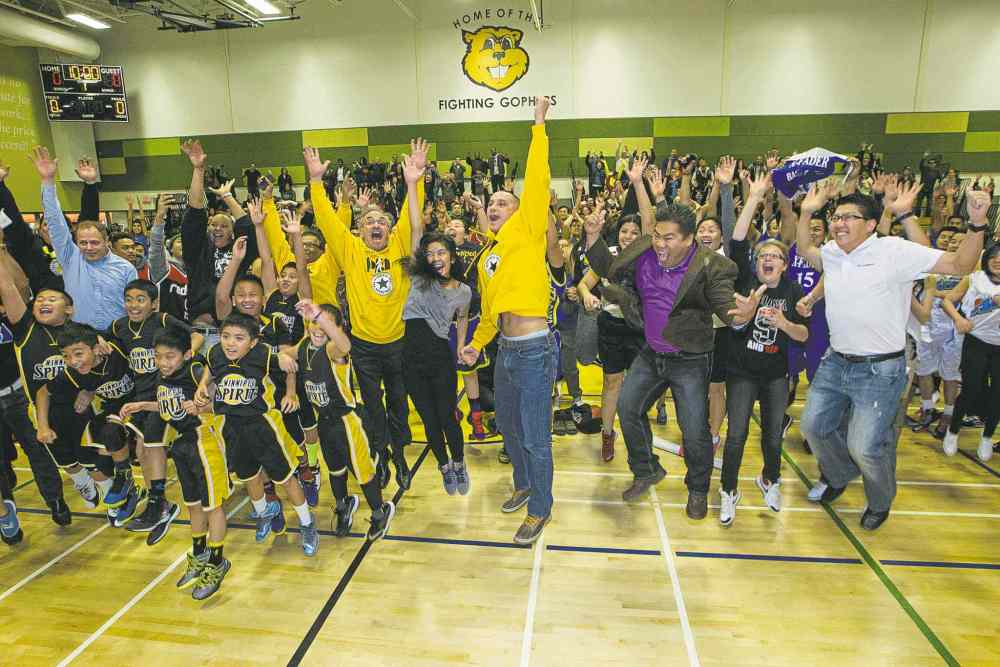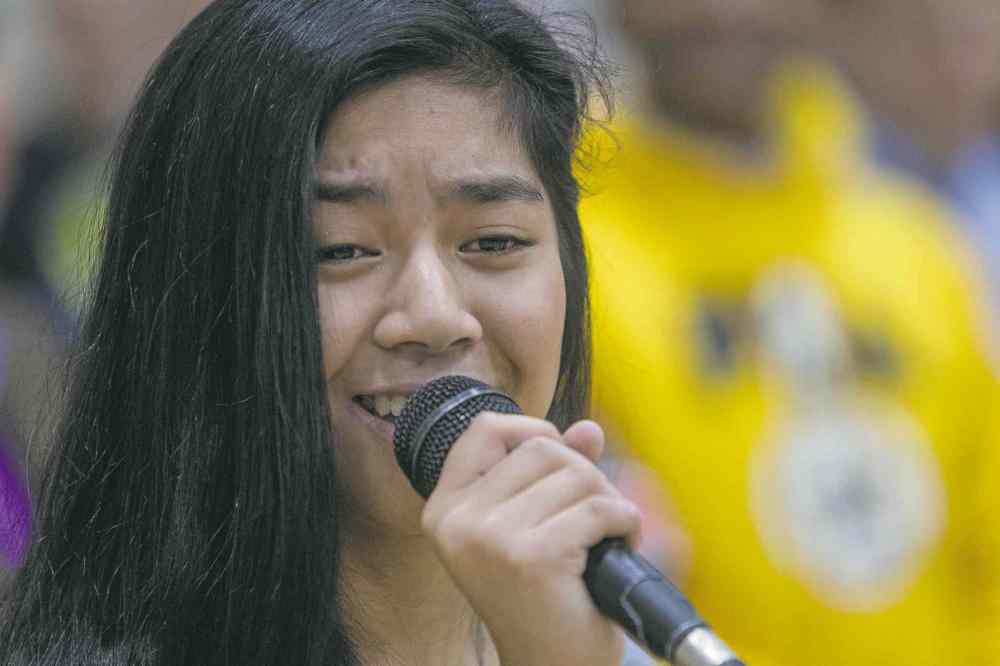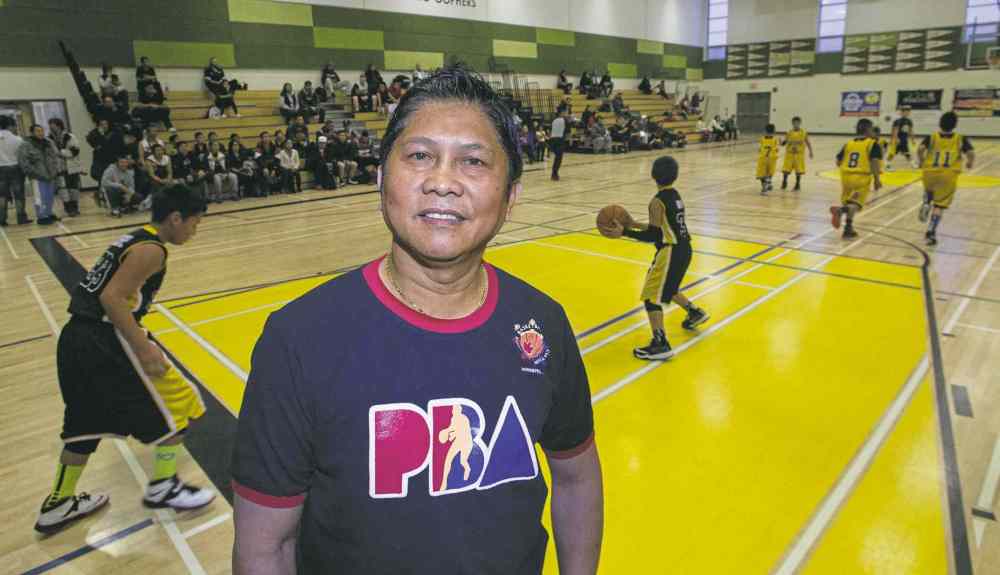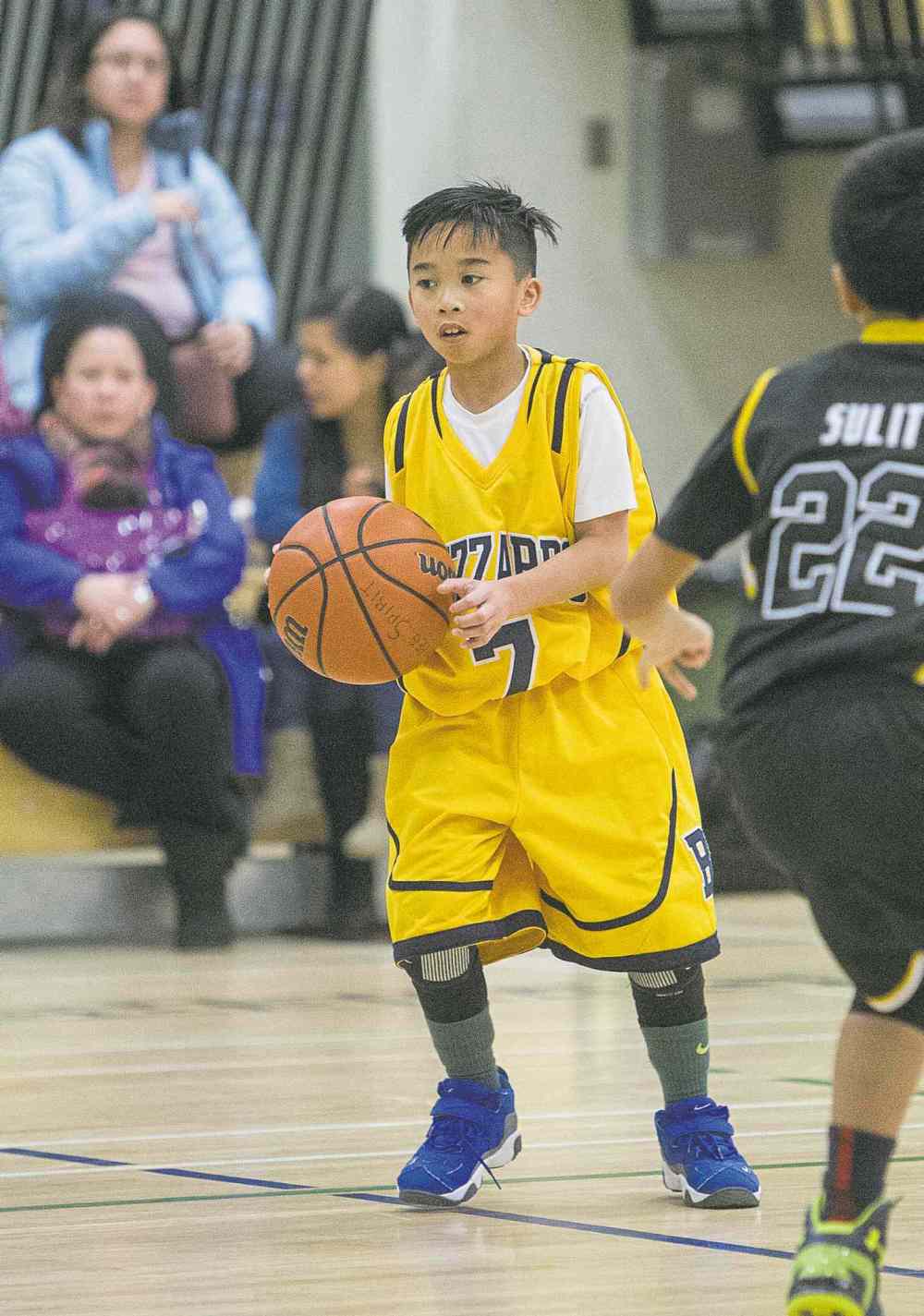They got game
For Manitoba's Filipino community, basketball is a more than a sport, it's a religion / D4-6
Advertisement
Read this article for free:
or
Already have an account? Log in here »
To continue reading, please subscribe:
Monthly Digital Subscription
$1 per week for 24 weeks*
- Enjoy unlimited reading on winnipegfreepress.com
- Read the E-Edition, our digital replica newspaper
- Access News Break, our award-winning app
- Play interactive puzzles
*Billed as $4.00 plus GST every four weeks. After 24 weeks, price increases to the regular rate of $19.00 plus GST every four weeks. Offer available to new and qualified returning subscribers only. Cancel any time.
Monthly Digital Subscription
$4.75/week*
- Enjoy unlimited reading on winnipegfreepress.com
- Read the E-Edition, our digital replica newspaper
- Access News Break, our award-winning app
- Play interactive puzzles
*Billed as $19 plus GST every four weeks. Cancel any time.
To continue reading, please subscribe:
Add Free Press access to your Brandon Sun subscription for only an additional
$1 for the first 4 weeks*
*Your next subscription payment will increase by $1.00 and you will be charged $16.99 plus GST for four weeks. After four weeks, your payment will increase to $23.99 plus GST every four weeks.
Read unlimited articles for free today:
or
Already have an account? Log in here »
Hey there, time traveller!
This article was published 27/12/2014 (3949 days ago), so information in it may no longer be current.
It is snowing lightly in north Winnipeg, and there is that distinct sound of crunching snow beneath boots and shoes as fans make their pilgrimage from all directions.
Inside, the facility is already bustling, and every seat in the stands is filled well before the first game is scheduled to start. The concession stands are humming, the politicians are doing their thing shaking hands and slapping backs, and there is a palpable feel of giddiness.
Moments later, a singer takes the microphone and — with the aid of a spirited crowd — two national anthems are enthusiastically belted out:

O Canada and… Lupang Hinirang — the national anthem of the Philippines.
Welcome, ladies and gentlemen, to Garden City Collegiate.
Welcome to the opening of the Philippine Basketball Association season.
THE PATRIARCH
It’s just after 9 a.m. on a Sunday morning, and the first game is underway at a daylong festival that is more religion than sport to so many in Winnipeg’s Filipino community.
The stars of the PBA’s Tykes Division (10 and under) are on the floor flashing their skills. Just a few metres away, the day’s menu is already available, including pancit palabok, grilled pork chops with rice along with lumpia, empanadas and ginataan.
It’s only now that Manny Aranez, the PBA’s founder and longtime commissioner, can take a breath.
“I get stressed-out because organizing is tough,” says Aranez, sporting a PBA T-shirt with “COMMISSIONER” emblazoned on the back. “I can’t sleep because I worry. So when this is over today, I will go home and relax. Well, maybe for a little bit.”
The day is already a few minutes behind schedule — not all that surprising since the opening ceremonies featured a parade of some of the PBA’s 104 teams spread out over 12 divisions, most of them led by a “muse” wearing the team colours and carrying a banner representing their sponsor.
There were speeches from Winnipeg North MP Kevin Lamoureux, Burrows MLA Melanie Wight, Point Douglas Coun. Mike Pagtakhan, local car dealer and PBA sponsor Larry Vickar and school division trustees.
Kevin Chief, the Point Douglas MLA and provincial cabinet minister who played basketball for the University of Winnipeg in the 1990s, breaks the speech routine by asking for the entire room — players, officials and the fans — to pose for a photo, everyone in the building jumping simultaneously for “Winnipeg’s biggest jumpshot.”
And Aranez is in there for every last bit of it, playing the MC, making sure the pace is right during the team introductions and crowning the muse who will represent Winnipeg when Filipino travelling teams head to New York for the annual Filipino Basketball Association North American tournament.
Indeed, for all the Filipino leagues and teams in Winnipeg — and the many, many volunteers who help make it work — Aranez is considered by many to be the patriarch.
Born in Balete, Lipa City, in the Philippines, Aranez immigrated to Canada 35 years ago at the age of 21. And he brought his passion for basketball with him.
“I didn’t have the opportunity to play organized basketball when I was younger because back home, you are limited to play on the real basketball courts… only the adults can play,” Aranez explains. “They are the kings of the courts.
“I just waited until everybody was done, when it was dark, and that’s when I started shooting the ball. I started when I was 12… I wish I had started when I was six or eight. And I didn’t start playing organized basketball until I went to high school. I had a little bit of time playing in college, but I mostly sat on the bench. I was too small.”
Now retired from his job at Deer Lodge as a caregiver, Aranez cut his teeth in Winnipeg’s Filipino community as a youth co-ordinator, making a number of business contacts en route. PBA Winnipeg started when his son and his friends, then teenagers, were looking for an organized outlet to play the game. Aranez helped provide their basketball fix by starting a league — then with just seven teams.
“This,” he said, nodding towards young kids on the court, “is my passion. I love seeing all the kids playing basketball. We’re not getting paid to do this. It’s for the love of the game. Basketball is the No.1 sport in the Filipino community. It’s everywhere.
“My son is in Calgary now working, but even though I don’t have a child playing, I’m still here. I just love watching the kids when they’re playing. I can stay all day at this without eating. I don’t remember, and then I get home and I have a headache or something, and I realize I haven’t eaten. When I’m at the basketball court, my wife says she doesn’t even bother calling me because I won’t answer the phone.

“I just love basketball. This is our culture. There’s a camaraderie that is built here. When I go to socials on a Friday or Saturday night, I don’t even have to pull out my wallet to buy a drink because everybody else is buying me one. “Tito” is uncle to us and a lot of people want to buy their Tito Manny a drink. I love these players, these people.”
THE PASSION
The Sunday morning at Garden City Collegiate is one tiny snapshot of the popularity of basketball in the Winnipeg Filipino community, which the most recent census numbers report now totals 65,000.
The PBA Winnipeg isn’t the only Filipino-based league — there are at least seven, and counting, Basketball Manitoba reports — nor is it limited to the capital region, as there are also leagues in Neepawa in western Manitoba and Steinbach in southeastern Manitoba. It’s estimated that of the local Filipino population of 65,000, 1,500 are registered in one league or another — and that doesn’t include those who play pickup basketball.
“How big is basketball in the Filipino community?” asks Ron Cantiveros, the publisher of the Filipino Journal. “Let’s just say that if I had endless amounts of money to print, we could pretty much have a Filipino Journal Basketball Edition every month from November to March. Maybe year-round.
“It’s more than just the game. It’s how newcomers to our city connect and assimilate. It’s about family.”
In addition to the PBA, there is the Winnipeg Athletic Association for Youth (WAAY), the International Kabayan Association of Winnipeg (IKAW), the Industrial Basketball League, the Life of Peg Basketball League, the Inter-Church Basketball League and the Church of God International Basketball League.
In short, the Filipino basketball community is one of those unique subcultures, sporting or otherwise, that makes Winnipeg so diverse; so, well, Winnipeg.
“I don’t think the non-Filipino basketball community even understands that this is going on or how deeply rooted it is,” says University of Manitoba Bisons head coach Kirby Schepp. “Watching a game between two predominantly Filipino teams is a unique experience in this town. I remember recruiting a kid from Grant Park a few years ago, and they were playing at Daniel McIntyre (high school). There was another coach from out of town recruiting this same kid, and we were basically the only Caucasian guys in the gym because it was filled with Filipinos.
“I remember him laughing and saying to me, ‘Where am I right now? Is this Winnipeg?’ “
That’s the first thing you notice at a PBA or WAAY game, or when one of the many school or club teams dominated by Filipinos are in action. There are more than just mothers and fathers in attendance, but brothers, sisters, aunts, uncles, grandparents, cousins…
“There’s a cultural aspect to it,” explains Lenin Mangaron, who played locally for Oak Park High School, the University of Manitoba, Brandon University, then semi-pro in the Philippines and now coaches at Sargent Park School while suiting up for the Ballers in PBA Winnipeg.
“Our culture has always been family-oriented. We don’t put our elderly into nursing homes, they stay at our houses. That’s why you see so many grandparents at games, aunts and uncles. That’s the tradition.
“If you see our gatherings away from basketball, everybody comes to our houses. The house is full, the garage is full… it’s just a Filipino cultural thing where we like to be with our family. I had a co-worker who said he had a Filipino neighbour and ‘Every two weeks or so you guys have something going on with your families… And the good thing is, we get food, too.’
“In a lot of ways, it’s like the passion many Canadians have for hockey. Remember, too, that the generations that have immigrated from the Philippines… all of them know basketball. They don’t know any other sports. They don’t know hockey. They don’t know football, because it doesn’t exist in the Philippines. They know soccer and volleyball, but 90 per cent of it is basketball. So when they come here, the first thing they think of is putting their kids into basketball.”
Alyssa Esperanzate and Jerome Santoyo are two perfect examples of the next wave of Filipino basketball diehards.
Esperanzate, a 14-year-old in Grade 9 at Sisler, currently plays for the Magic, but was also part of a Manitoba squad that participated in the FBA-North America tournament in Windsor in September and captured a third straight gold medal.

Santoyo, 15, also attends Sisler where he plays for the junior varsity squad. He also plays for the Winnipeg Blizzards club team and was a member of the Manitoba U-15 provincial team that finished fourth at this summer’s nationals.
You want passion?
“When I first started playing, I got this feeling I was part of a big family right away,” says Esperanzate. “Everyone is just so close. We all care about each other and there’s a bond. And in my second year, that grew even more… I felt like I was part of this big community. There’s so much support. If I have a friend playing, my family might come and watch. It’s actually kind of cute.
“And when we have those moments as teammates when we get frustrated with each other, they don’t last long. You can’t stay mad at family, right?”
Both Esperanzate and Santoyo have dreams beyond high school. They both hope the game could take them to the university level and help pay for part of their education.
“I think about basketball all the time, on and off the court,” says Santoyo. “I love playing basketball, it’s a great passion of mine. And when me and my family see Filipino players at the next level, like university, we cheer for them even though we might not even know them.
“Guys like Joseph Medrano (at the University of Manitoba) and Jonar Huertas (in the PBA D-League in the Philippines) are big stars in the Filipino community. If I could work on my game and play university like them… that would be a dream come true. Those two guys are big role models for somebody like me.”
THE FILIPINO INFLUENCE
Gyms come in all shapes, sizes and dimensions, but an official basketball court — by International Basketball Federation (FIBA) rules — should measure 91 feet, 10.4 inches by 49 feet, 2.6 inches.
The sizes for high school, junior high and elementary courts, understandably, vary.
Those dimensions don’t matter to Filipino-based club or school teams, or squads coached by Filipinos. Their mantra is always the same: pressure the basketball on every square inch of the floor.
“We have a mentality about that,” says Arsenio Dela Cruz, an electrician with CN Rail who is also a coach, a longtime volunteer with WAAY and the president of the Manitoba Magic basketball club. “I can’t speak for everybody, but our goal at the Magic is to pressure the ball-handler. We often have a size disadvantage, so the more pressure we put on the ball-handler, the harder it is to put it inside to the bigger guys. We go based off speed and those court traps.
“We always expect to be the underdogs. We expect to be out-rebounded. But the one thing Filipino teams have in common is ball pressure.”
Now, to suggest the Filipino approach has changed the way basketball is played in Winnipeg — or North America, for that matter — would be more than a bit dramatic. After all, basketball has evolved radically since the days James Naismith first cut a hole in the bottom of a peach basket.
But ask any club or school team in this town that has faced a Filipino-based squad and the message is always the same: Get ready for a full-court press and a track meet from the opening tip to the final horn.
“I saw it growing up,” says Mangaron, the former university star now coaching at Sargent Park. “Filipinos reach physical maturity, it seems, at a younger age. And that’s why they dominate some of the youth leagues and games.
“I’ve coached from kindergarten age to junior high and the truth of the matter is — and I’m going by data here — Filipinos dominate those age groups. Look at the junior high finals and almost every year and it’s Stanley Knowles, Sisler, Sargent Park or some school where there is a high number of Filipinos.
“But that’s where it stops, except for the odd exception. Every other race grows, and the Filipinos stop growing. That’s the equalizer. I always joke around with all the non-Filipino coaches that I’m trying to find the pill to make us grow more.”
Worth noting here: Christian David, a 6-5 Filipino-Canadian shooting guard out of Bishop Redding High School in Milton, Ont., is ranked the top prospect of the 2017 graduating class in this country by North Pole Hoops and already has NCAA offers from Illinois, Baylor, Oregon and St. Bonaventure.

“It would be so cool if Filipino-Canadians had a torchbearer like that,” says Dela Cruz. “What I’ve noticed in the last few years is the Filipino kids who are coming over are a lot bigger, a lot faster, a lot stronger. I don’t know why, but it’s interesting. Maybe there is a star in the making among them.”
THE PROTEGE
Jonar Huertas has always felt most comfortable with a basketball in his hands.
He fell in love with the game playing his first organized basketball at Stanley Knowles school in Grade 7, the first step in a road that took him to Sisler High School — where he helped guide the Spartans to a provincial championship in 2006 — and then to the U of M Bisons.
But when he finished university, the doors seemed to close. One did swing open, however, and it’s completed a circle of sorts for Huertas and his family.
“I’ve always been playing the Filipino leagues in Winnipeg and the guys involved in that league, guys like Manny Aranez, have always been passionate about the ball in the Philippines,” says Huertas in a telephone interview from Manila. “They told me to try it out and, after my fourth year at the U of M when I had a pretty solid year, I thought, ‘Why not?’
“You want to take this is as far as you go. I didn’t want to look back, say four or five years from now, and be kicking myself or wishing I would have tried this.”
Huertas is playing for the Café France Bakers in the PBA D-League, a minor-league circuit similar to the NBA’s D (Developmental) League. Next year, he will be eligible for the PBA draft and could soon be playing in the second-oldest professional basketball league in the world, second only to the National Basketball Association.
Basketball is the de facto No. 1 sport in the Philippines — one of only a handful of nations where the game has that distinction along with Lithuania, China, Estonia and Latvia — and the evidence is there almost every night at a PBA game.
“I went to a game the other day between the Barangay Ginebra Kings and San Miguel Beermen,” says Huertas, who had never been to the Philippines before. “It was a rivalry game, and there were 18,000 people. Packed house. The fans are passionate. There were signs everywhere. It’s funny, players would just be going for a loose ball or a rebound and the fans are screaming. That’s the type of environment. Kind of like back home in Winnipeg at a PBA game.
“What’s interesting is growing up in Winnipeg, I never thought I’d want to come out here. But it’s one of the better opportunities for me. Not too long ago, I went to the house that my parents grew up in. They still own the house. I live in my grandparents’ house, which is just outside the city.
“Some days when you’re doing nothing or I’m finished training, I think about where I came from and all the steps I took to get here. It’s surreal.”
Some of those steps took place at Garden City Collegiate on a Sunday. For others it was at a WAAY game as a kid at Gordon Bell High School… all with parents and grandparents, sisters and brothers and Tito Manny watching closely.
It takes a village, all right. It takes a whole Filipino community.
“Jonar… he’s my boy,” beams Aranez. “I talked to him almost every night. He’s awesome. He was determined to go there and play big-time basketball. He’s close now. It’s like he’s representing us, our PBA.”
ed.tait@freepress.mb.ca Twitter: @WFPEdTait

